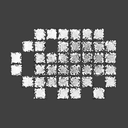hi,
i want to do the following:
while a tempo is running i want to hit a rythmic phrase on a key of the computer.
that phrase shall be recorded over a lets say 12 or 16 or notes long bar to and immediatly being played back afterwards.
how could i start this?
y
-
Record pattern
-
hi,
the thing with storing a pattern in table i do not completely understand.
i have written a sequencer in pd. it sends 32 bangs. to change the patterns i have to open a windows, change the 1 and 0 values of the toggles, click a bang and then it plays the new pattern. it also remembers the new pattern if i hit safe. only then the timing gets affectet.
i like the idea with the table very much.
>when a key is pressed, write a value into the table at the current count number.
how to do that?
how to read it out?
ymy version of sequencer 32steps 5drumlines
http://www.kulturserver-nrw.de/home/stklg/sequencer32.pd -
i think now i got to understand some about it...
-
yeah it looks like you're basically on track. if something needs help, let us know.
-
There's also the unquantized approach using 2 tables (fixed to the max number of notes in a sequence). In one table you record the note value (or frequency) in the second table you write the timeinterval between the current and previous note event (using the [timer] object).
When playing back the sequence you would need to use a [del] object fed with the info from the timeinterval table to trigger the playback of the next note of the notes-table. This way you could multiply (or divide of course) the timeinterval values to speed the sequence up or slow it down.
But i'm working on this right now. I'll post it once i've got something working.
D.
|] [] |.| ][|-| -- http://soundcloud.com/domxh
-
yesterday i came to the idea to use two tables. to e able to have binary phrasing and move into triplets. to explore african timing...or something like that.
do i understand this right?
you mean to record a free rythmic phrases not relatet to an ongoing beat? -
Yes indeed. But after recording you just end up with a bunch of numbers in two tables. The way you play them back could be unrelated to the way you recorded them. There's lot's of interesting stuff you could do with the timing. E.g. you can:
- count the first 16 (or 24, or 36, or...) events
- divide that by a time (e.g. from a 16step sampleslicer is running) to get their ratio
- use that ratio to multiply with the times in the timetable to make the two patch run in sync
and then with the frequency table you can do all kinds of things...
That's really the fun thing about pd that you can relate all kinds of parameters other workstation programs haven't forseen...
Have fun,
D.
|] [] |.| ][|-| -- http://soundcloud.com/domxh
-
Well here is the rhythm quantiser based on hardoff's technique, with a second metro that counts in double time so that quantisation can be rounded up or down.
Domien, I would love to see your idea realised... please

Dual 1.8 IBM G5: Mac OSX 10.4.11 -- Asus eeePC 701: Pure:Dyne / eeeXubuntu GNU/Linux -- myspace.com/thearifd
-
Hey Arif,
I'm currently working on a rough prototype... So far i've got the basics implemented: recording pc-keyboard phrases and playing them back with 2 sliders to slow down or speed up + a range to determine playback length. Oh well, that's all probably rather fuzzy when you read it like that. Oh yes, i'm using it right now to play the superb Twin2 vst plugin which is the most amazing synth i've tried in years (or maybe months
 )...
)...|] [] |.| ][|-| -- http://soundcloud.com/domxh
-
well look here: http://puredata.hurleur.com/sujet-2528-super-mario for a dumb but fun application of this record pattern idea.
Domien, with some kind of maths (haven't figured it out yet, brain too tired right now) you could round up/down the timer values to their nearest quantization block, and thus still implement a quantise feature!

And if you could have a percentage of quantise slider that would be crazy good.
Dual 1.8 IBM G5: Mac OSX 10.4.11 -- Asus eeePC 701: Pure:Dyne / eeeXubuntu GNU/Linux -- myspace.com/thearifd

